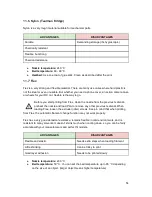
11.6 Nylon (Taulman Bridge)
Nylon is a very tough material suitable for mechanical parts.
ADVANTAGES
DISADVANTAGES
Durable
Demanding storage (it’s hygroscopic)
Chemically resistant
Flexible, but strong
Chemical resistance
● Nozzle temperature:
240 °C
● Bed temperature:
80 -
90 °C.
● Heatbed:
Use one coat of glue stick. Clean as described after the print.
11.7 Flex
Flex is a very strong and flexible material. There are many use cases where hard plastic is
not the ideal or even unusable. But whether you need a phone cover, an action camera case
or wheels for your RC car, flexible is the way to go.
Before you start printing from Flex, clean the nozzle from the previous material -
preheat the nozzle and load PLA to remove any other previous material. When
loading Flex, loosen the extruder (idler) screws. Keep in mind that when printing
from Flex, the automatic filament change function may not work properly.
Flex has a very good abrasion resistance, remains flexible in cold environments, and is
resistant to many solvents. It doesn’t shrink much when cooling down, so you can be fairly
accurate with your measurements and perfect fit models.
ADVANTAGES
DISADVANTAGES
Flexible and elastic
Needs extra steps when loading filament
Little shrinking
Can be tricky to print
Good layer adhesion
Needs to be printed slowly
● Nozzle temperature:
230 °C
● Bed temperature:
50 °C. You can set the bed temperature up to 65 °C depending
on the size of an object. (larger object means higher temperature)
54
Summary of Contents for i3 MK2.5
Page 1: ......
Page 64: ...Pict 40 Nozzle change 64 ...
















































